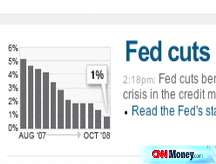Lending grows - first time since Lehman collapse
For the first time in 7 weeks, a critical source of short-term funding for businesses and banks grows, as Fed buys up $143.9 billion in corporate debt.
NEW YORK (CNNMoney.com) -- A key market for lending to major businesses and banks expanded for the first time in seven weeks, after the government bought nearly $144 billion in corporate debt this week, according to a Federal Reserve report released Thursday.
The amount of so-called commercial paper that was sold in the seven days ending Wednesday rose by $100.6 billion, or 6.9%, to a seasonally adjusted $1.5 trillion. Still, lending lags behind levels from a year ago when $1.9 trillion changed hands.
But the Fed's unprecedented actions to buy up hundreds of billions of dollars of high-quality, three-month commercial paper, appears to be paying off.
"The program is definitely working," said Steve Van Order, fixed income strategist at Calvert Funds. "It has lessened the pressure on banks to lend to corporations, and borrowers are getting access to credit that they couldn't previously get."
Commercial paper is short-term debt that big businesses and financial institutions sell primarily to money market fund managers and other institutional investors. The companies use the loans to fund day-to-day business operations. The market for it, particularly for three-month paper, dried up after the collapse of Lehman Brothers in mid-September.
Over the previous six weeks, outstanding commercial paper had fallen 20.2% - the greatest drop on record - to its lowest point since April 2005. Business lending had been steadily declining since Lehman's bankruptcy filing.
But starting Monday, the Fed has been buying droves of corporate debt through its Commercial Paper Funding Facility. According to Fed data released Thursday afternoon, the central bank bought $143.9 billion in commercial paper through its program.
Accordingly, the market for three-month paper has grown exponentially. The Fed said commercial paper issued Wednesday with maturities of more than 80 days stood at $62.6 billion. On Monday, $67.1 billion of long-term paper was issued, and on Tuesday another $41.6 billion was added - making this week's total nearly $171.4 billion. That's up significantly from last week's $33.5 billion. Monday saw the largest amount of long-term corporate debt purchased in one day since the Fed began maintaining records in 2001.
"This is almost all from the Fed," Van Order said. "As time goes by, though, we'll be looking at the trend of issuance volume versus how big the Fed's program gets."
The Fed is offering competitive rates in its commercial paper program, currently standing at 1.74% for unsecured debt and 3.74% for asset-backed commercial paper. Paper of lower credit quality is often backed with assets to entice borrowing, but rates are higher.
Many analysts have said the Fed's offer of low 3-month commercial paper rates will help nudge other rates lower. Accordingly, most commercial paper rates fell this week compared to last week. The lower rates are also helping bring down the 3-month Libor rate - which fell by more than 0.2 percentage points Thursday. That's a major boost for the strangled credit market, as more than $350 trillion is assets are tied to Libor.
"The program is helping Libor step down," Van Order said. "The data suggests the program is off to a good start."
Lower interest rates make it easier for companies to lend to one another. The Fed hopes its actions encourage lending and help bring the credit crisis to an end.
The Fed's new program gave companies access to critical longer-term financing. In the past week, 26.7% of all commercial paper outstanding matured in more than 80 days, compared to just 4% in the previous week. Before Lehman's collapse, the three-month paper made up more than 11% of the market.
"The maturity distribution is good news," said Van Order. "Hopefully people will continue to get comfortable out there in the three-month sector."
The lack of longer-term lending in the previous month and a half worried companies looking for financing for the last few months of the year. The fourth quarter is the most critical period for lending, as financial institutions are hesitant to lend with the risk of taking a hit to their balance sheets at the end of the fiscal year. Uncertainty over the looming election has also made investors wary of doling out their funds.
The Fed's actions have been criticized by some analysts who believe the facility doesn't address the sellers of lower quality paper, who have suffered the most since the credit crisis put a stranglehold on lending. Still, other economists say the Fed's efforts have helped restore confidence to the market.
Several dozen companies registered for the Fed's program, including General Electric Co. (GE, Fortune 500), which is the largest issuer of commercial paper. Morgan Stanley (MS, Fortune 500) topped the names of Wall Street firms that registered. Car and home lender GMAC (GMA) said it was approved to make use of the facility, and American Express (AXP, Fortune 500) said it intends to use the facility as well.
"This is still the early stages," Van Order said. "When the government is in a position to unwind its market positions and make lending more punitive, that would be even better. But if we're stuck in a recession for several quarters, the government's programs will be in place for a while."
Another company that said Thursday it will participate in the commercial paper facility was troubled insurer AIG (AIG, Fortune 500). Through four of its subsidiaries, AIG will sell $20.9 billion of debt to the Fed, using the proceeds to pay back the $85 billion government bailout loan it was offered in mid-September. The move allows AIG to pay down a big chunk of its initial government loan - on which it is currently paying 11.7% in interest - with money it has borrowed at 4% through the Fed's commercial paper program. ![]()



